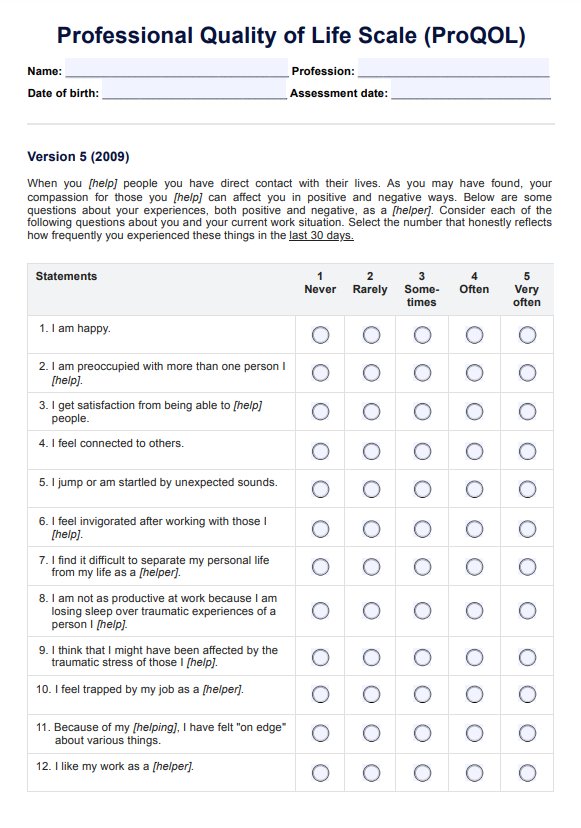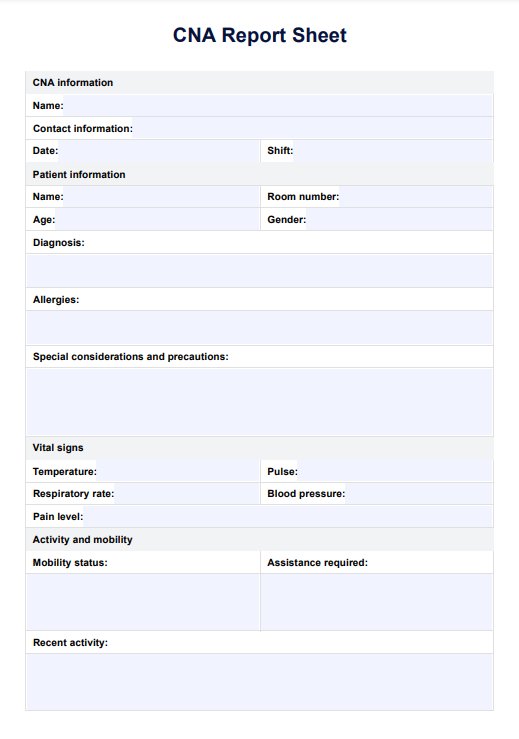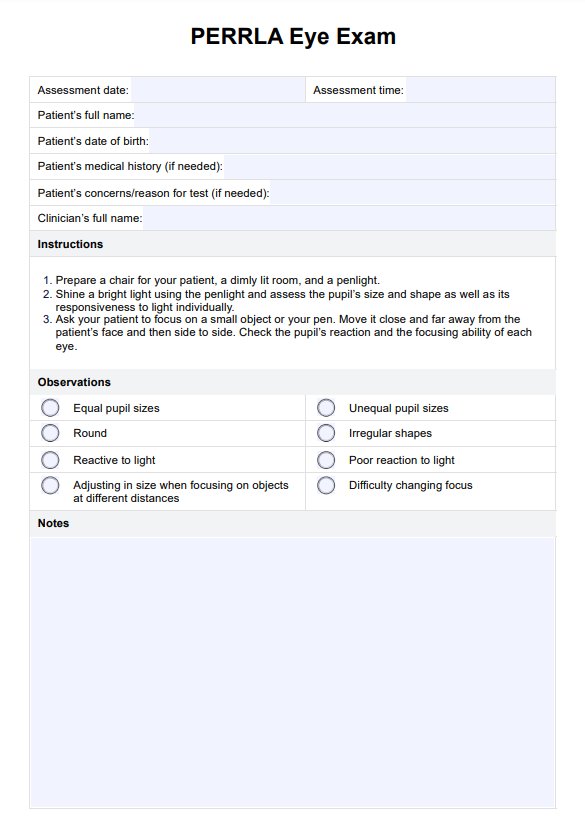Elastography
Learn about the non-invasive Elastography Test for tissue assessment. Valuable for liver, breast, and more. Discover its many uses and benefits.


What is an Elastography Test?
Elastography is a medical imaging technique used to assess the elasticity or stiffness of tissues within the human body. It is valuable in the diagnosis and monitoring of various medical conditions, most notably in the field of radiology and ultrasound imaging. The primary objective of elastography is to provide additional information about tissue characteristics that cannot be obtained through traditional imaging methods like X-rays or standard ultrasound.
There are two main types of elastography:
- Strain Elastography: This technique measures the deformation or strain of tissues when subjected to an external force. By comparing the tissue's initial shape with its deformed state, clinicians can assess the tissue's stiffness. Strain elastography is often used in breast imaging to detect breast tumors. Softer tissues, like cysts, deform more easily than stiffer tissues, such as tumors.
- Shear Wave Elastography: This method generates shear waves within the tissue and measures their propagation speed. Stiffer tissues transmit these waves faster than softer ones. Shear wave elastography provides quantitative data about tissue stiffness and is commonly used for assessing liver fibrosis, as liver stiffness is a crucial indicator of liver health.
Elastography has a wide range of applications across various medical specialties, including assessing the stiffness of the prostate, detecting thyroid nodules, and evaluating musculoskeletal disorders. It has become an essential tool for non-invasive diagnosis and monitoring of conditions that affect tissue elasticity.
Elastography Test Template
Elastography Test Example
How Does it Work?
Elastography assesses the mechanical properties of tissues within the body, particularly their elasticity or stiffness. Here's a concise overview of how it operates:
Mechanical Waves
Elastography involves applying mechanical waves to the tissue of interest. These waves can be generated externally, such as through manual compression or a vibrating probe, or internally, using acoustic radiation force.
Deformation Measurement
As the mechanical waves interact with the tissue, they cause deformation or displacement within the tissue. This deformation can be observed using various imaging modalities, like ultrasound or MRI.
Image Acquisition
Specialized imaging equipment, such as an elastography ultrasound machine or MRI scanner, captures tissue images deformed.
Comparison with Baseline
The deformed tissue images are then compared to baseline or pre-deformation images. This comparison helps to quantify how much the tissue has deformed and in what direction.
Color-Coded Maps
The resulting data is often represented as color-coded maps, where softer tissues appear in one color (e.g., blue) and stiffer tissues in another (e.g., red). The color intensity indicates the degree of tissue stiffness.
Quantitative Assessment
The shear wave elastography measures the speed of shear waves generated within the tissue. Stiffer tissues transmit shear waves faster; this data is used for quantitative assessment of tissue stiffness.
Clinical Interpretation
A trained healthcare provider interprets the elastography images and quantitative data. They assess the tissue's stiffness and use this information to diagnose or monitor various medical conditions.
When Would you use this Test?
Elastography tests find widespread use across various medical specialties and are valuable in several clinical scenarios. Here are some key situations when healthcare practitioners might employ elastography tests:
- Liver Disease Assessment: Gastroenterologists and hepatologists frequently use elastography to evaluate liver health. Liver stiffness measurement helps assess the degree of liver fibrosis, aiding in diagnosing and staging liver diseases such as hepatitis and cirrhosis. It reduces the need for invasive liver biopsies, making it a safer and more convenient option for patients.
- Breast Cancer Detection: Radiologists and oncologists utilize elastography, particularly strain elastography, to complement mammography and ultrasound in breast cancer screening. It assists in distinguishing between benign and malignant breast lesions by assessing their stiffness. This aids in early cancer detection and reduces unnecessary biopsies.
- Thyroid Nodule Evaluation: Endocrinologists and thyroid specialists may use elastography to assess thyroid nodules. It helps differentiate between benign and malignant nodules, guiding treatment decisions and reducing unnecessary surgical interventions.
- Prostate Health: Urologists often employ elastography to assess the prostate gland. It assists in identifying suspicious areas within the prostate, which can aid in the early detection of prostate cancer.
- Musculoskeletal Disorders: Rheumatologists and orthopedic specialists use elastography to assess musculoskeletal conditions. It helps identify areas of inflammation, tissue damage, or joint abnormalities, aiding in diagnosing and managing conditions like arthritis and tendonitis.
- Cardiovascular Applications: Cardiologists may use elastography to assess arterial stiffness, providing insights into a patient's cardiovascular health. It helps in evaluating the risk of hypertension and other cardiovascular diseases.�?�
- Gynecological Assessments: Gynecologists might use elastography to evaluate pelvic organs, such as the cervix and uterus. It can assist in detecting abnormalities, including cervical cancer or uterine fibroids.
What do the Results Mean?
Interpreting elastography test results requires a thorough understanding of the specific medical condition being assessed and the context of the examination. However, here are some common results and their interpretations:
Soft or Low Stiffness (Blue Areas): Soft or low stiffness areas in elastography images typically indicate healthy or normal tissue. For instance:
- In breast elastography, predominantly blue regions suggest that a breast lesion is likely benign, reducing the need for a biopsy.
- In liver elastography, lower stiffness values (measured in kPa) may indicate minimal or no fibrosis, which is favorable for liver health.
Stiff or High Stiffness (Red Areas): Stiff or high stiffness areas often raise concern and may suggest pathology:
- In breast elastography, red areas may indicate increased tissue stiffness associated with malignant breast tumors, prompting further evaluation.
- In liver elastography, high stiffness values may suggest advanced liver fibrosis or cirrhosis, indicating the need for closer monitoring and potential treatment.
Mixed or Heterogeneous Patterns: Mixed patterns with a combination of blue and red areas can be more challenging to interpret and may require additional tests or clinical correlation. In thyroid elastography, a heterogeneous pattern might indicate a thyroid nodule with variable stiffness, requiring further investigation.
Quantitative Stiffness Values: Elastography provides numerical stiffness values (measured in kPa) for tissue. These values can be compared to established thresholds:
- Liver elastography values within a specific range may correspond to different fibrosis stages, guiding treatment decisions.
- In prostate elastography, stiffness values can help identify suspicious regions requiring targeted biopsies.
Serial Monitoring: Elastography can also monitor tissue stiffness changes over time. Improvements or worsening of stiffness can inform treatment effectiveness or disease progression.
Research & Evidence
Elastography is a relatively recent development in medical imaging, with its history spanning the last few decades. The technique emerged as a response to the limitations of traditional imaging methods and has since gained substantial research and clinical support.
Elastography was first introduced in the 1990s as a novel ultrasound imaging technique. The initial focus was assessing breast lesions and distinguishing between benign and malignant tumors. Over the years, elastography expanded to other medical specialties, including liver disease assessment, musculoskeletal imaging, and more.
Extensive research has validated the utility of elastography across various medical conditions. Numerous studies have demonstrated its effectiveness in improving diagnostic accuracy and reducing the need for invasive procedures like biopsies. Liver elastography, for example, has been extensively researched and is now widely accepted as a non-invasive method for assessing liver fibrosis and cirrhosis.
In breast cancer diagnosis, elastography has been shown to complement traditional mammography and ultrasound, reducing the number of unnecessary breast biopsies and improving the early detection of malignancies. Research continues exploring new elastography applications in cardiology, gynecology, and ophthalmology.
Leading medical organizations, such as the American College of Radiology (ACR) and the European Association for the Study of the Liver (EASL), have developed guidelines and recommendations for using elastography in clinical practice. These guidelines provide healthcare professionals with standardized protocols for performing elastography and interpreting results.
References
- Afdhal, N. H. (2012, September 1). Fibroscan (Transient elastography) for the measurement of liver fibrosis. PubMed Central (PMC). https://www.ncbi.nlm.nih.gov/pmc/articles/PMC3594956/
- Barr, R. G., Wilson, S. R., Rubens, D. J., Garca??Tsao, G., & Ferraioli, G. (2020). Update to the Society of Radiologists in Ultrasound Liver Elastography Consensus Statement. Radiology, 296(2), 263??274. https://doi.org/10.1148/radiol.2020192437
- Dhyani, M., Anvari, A., & Samir, A. E. (2015). Ultrasound elastography: liver. Abdominal Radiology, 40(4), 698??708. https://doi.org/10.1007/s00261-015-0373-4
- Duhaime, E. (2017). Hepatitis C. Physician Assistant Clinics. https://doi.org/10.1016/j.cpha.2016.12.012
- Jackson Hospital. (2022, June 1). US Elastography | Jackson Hospital. Jackson Hospital |. https://www.jackson-hospital.com/medical-services/us-elastography/
- O??Shea, A., & Pierce, T. T. (2021). US Elastography in Hepatic Fibrosis??Radiology In Training. Radiology, 299(2), 264??271. https://doi.org/10.1148/radiol.2021203893
- Radiological Society of North America (RSNA) and American College of Radiology (ACR). (n.d.). Elastography. Radiologyinfo.org. https://www.radiologyinfo.org/en/info/elastography
- Silver, N. (2022, November 16). What??s a liver elastography? Healthline. https://www.healthline.com/health/elastography-liver
- The Royal Australian College of General Practitioners. (n.d.). FibroScan and transient elastography. Australian Family Physician. https://www.racgp.org.au/afp/2013/july/fibroscan
- Weber, B. (2022, July 28). What to know about liver elastography. https://www.medicalnewstoday.com/articles/elastography-liver
Commonly asked questions
Elastography tests are typically requested by healthcare providers, including radiologists, hepatologists, oncologists, and other specialists, based on the patient's medical condition and symptoms.
Elastography tests are used when there is a need to assess tissue stiffness or elasticity for diagnostic purposes. They are commonly used for liver fibrosis staging, breast lesion characterization, thyroid nodule evaluation, and more.
Elastography tests involve applying mechanical waves to tissues and imaging the resulting tissue deformation to assess stiffness. Depending on the clinical need, the technique can be performed using ultrasound, MRI, or other imaging modalities.


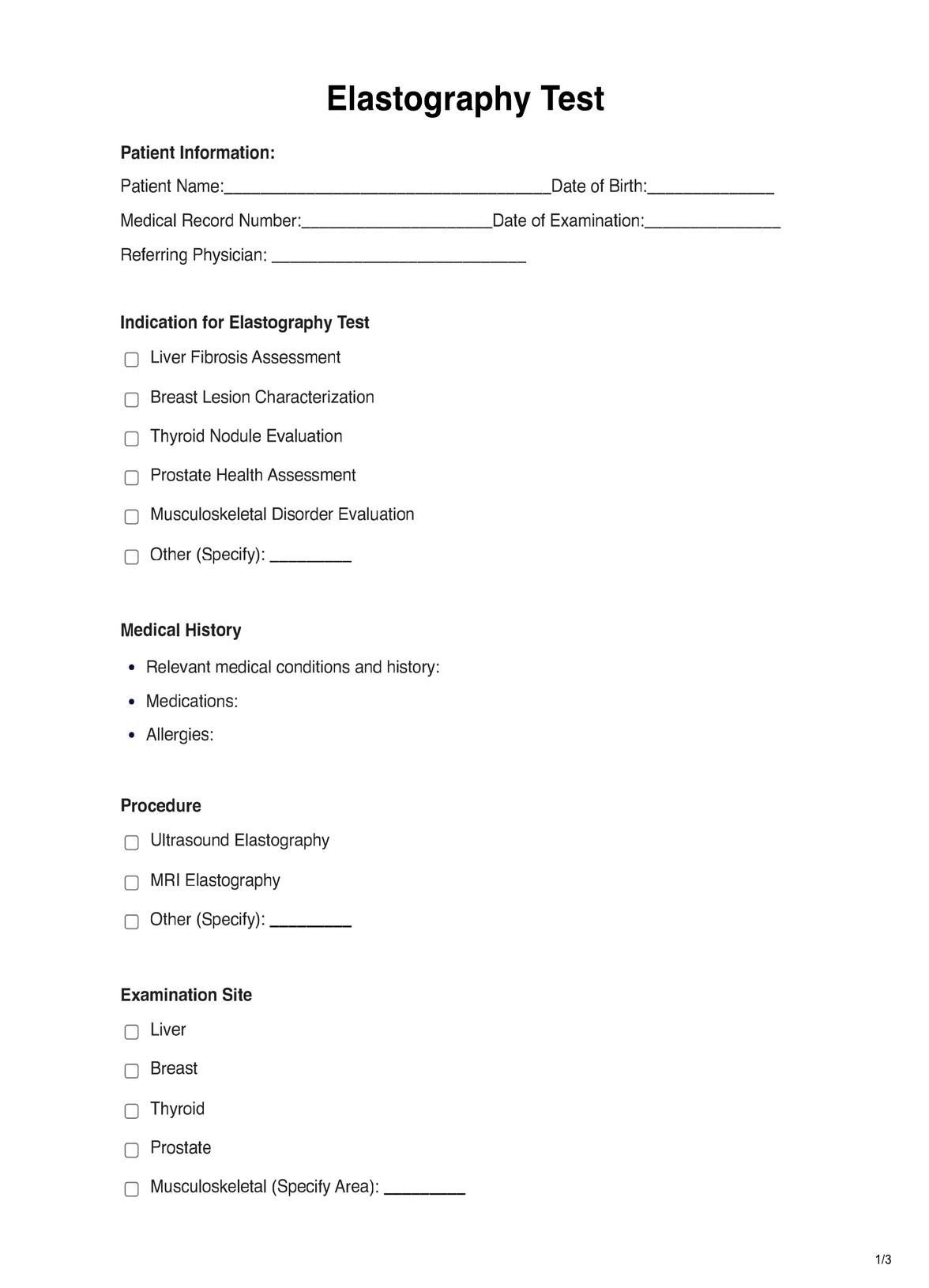
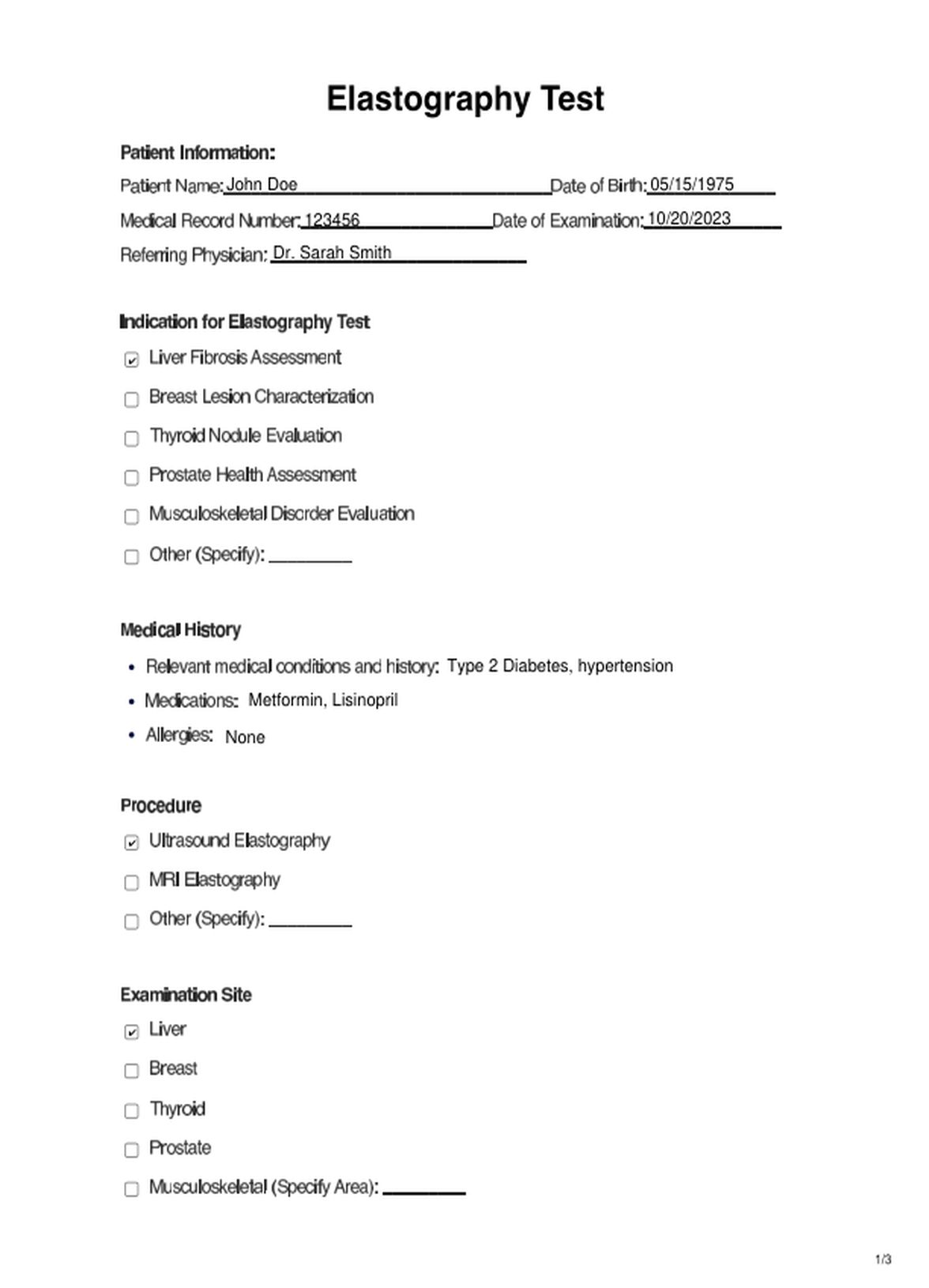
















-template.jpg)


















































































